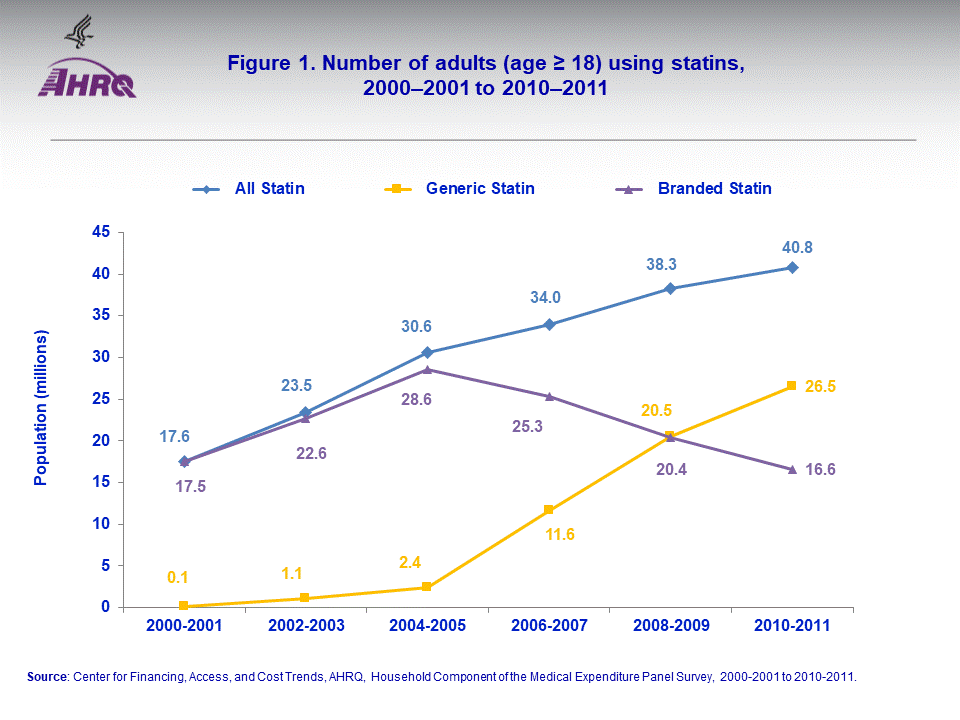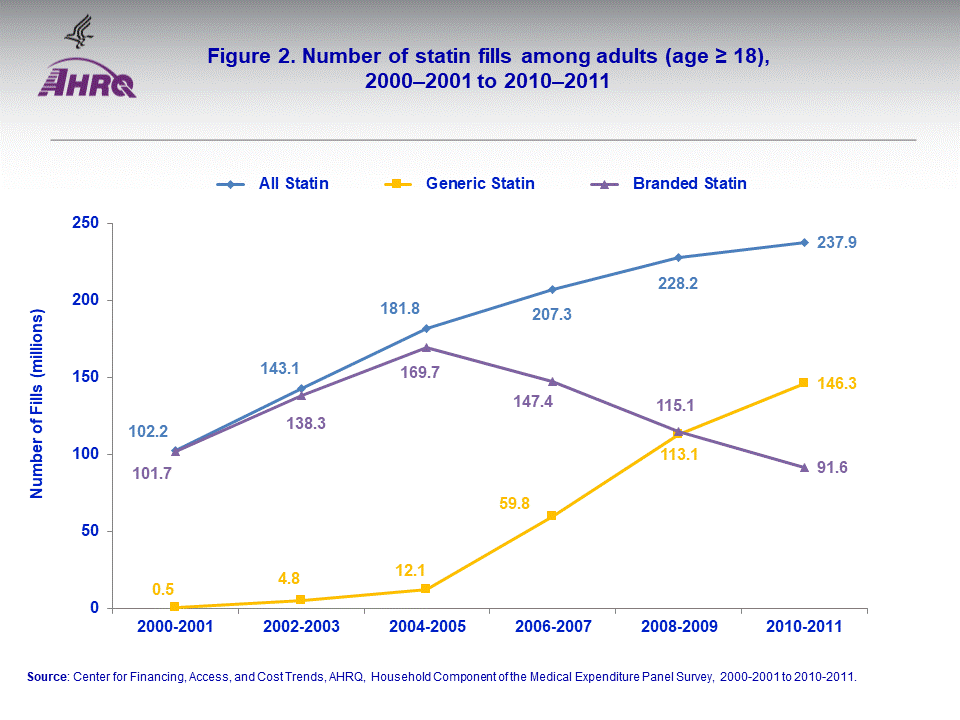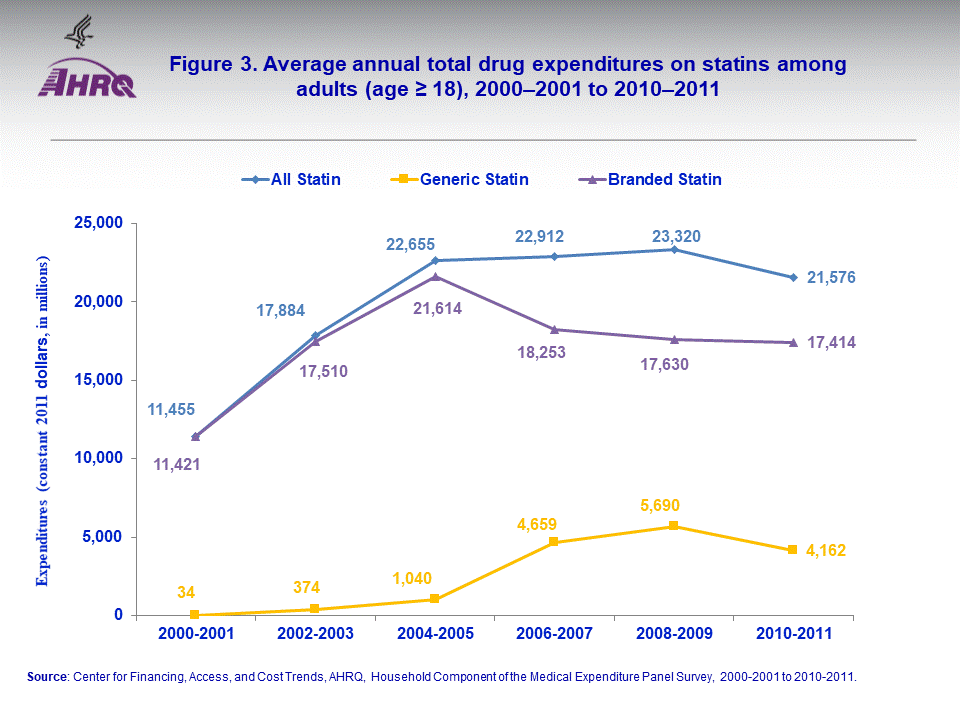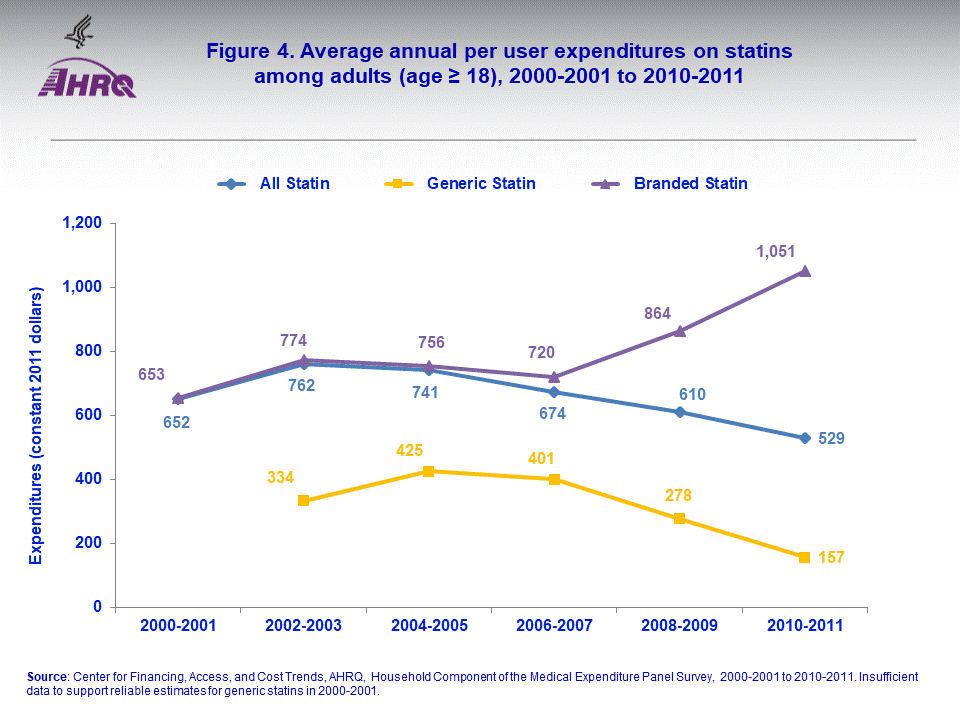
|
|
Font Size:
|
||||
|
|
|
|
||||
STATISTICAL BRIEF #458:
Trends in Statin Therapy among Adults (Age ≥ 18), United States, 2000 to 2011
Highlights
- The number of adults (age ≥ 18) who reported using prescribed statins increased from an average 17.6 million annually in 2000–2001 to 40.8 million in 2010–2011.
- Between 2000–2001 and 2010–2011, the number of adults who reported using prescribed generic versions of statins increased from 0.1 to 26.5 million annually.
- The number of statin prescriptions filled by adults (age ≥ 18) increased from an average 102.2 million annually in 2000–2001 to 237.9 million in 2010–2011.
- Among adults (age ≥ 18), annual total expenditures (in constant 2011 dollars) for all statins rose, on average, from $11.5 billion in 2000–2001 to $21.6 billion in 2010–2011.
- Between 2000–2001 and 2010–2011, per user average annual expenditures (in constant 2011 dollars) among adults (age ≥ 18) fell from $652 to $529 for all statins, and rose from $653 to $1,051 for prescribed branded statins.
Introduction
High cholesterol (i.e., dyslipidemia or disorder of lipoprotein metabolism) is a major risk factor for heart disease, the leading cause of death in the U.S.1 Individuals diagnosed with high cholesterol rely, primarily, on 3-hydroxy-3-methylglutaryl-coenzyme (HMG-CoA) reductase inhibitors or statins to manage their condition. Recently, the American Heart Association (AHA) and the American College of Cardiology (ACC) published new clinical practice guidelines on the treatment of blood cholesterol to reduce atherosclerotic cardiovascular (ASCVD) risk in adults.2,3This Statistical Brief examines trends in statin use and expenditures among adults (age ≥ 18) in the U.S. using nationally representative data from the 2000 to 2011 Medical Expenditure Panel Survey (MEPS). Data from 2000–2001 to 2010–2011 are pooled to increase sample sizes and the precision of estimates, thus results are presented as average annual estimates for these time periods. Expenditures for all years are expressed in constant 2011 U.S. dollars. All differences between estimates discussed in the text are statistically significant at the 0.05 level unless otherwise noted.
Findings
The number of adults (age ≥ 18) who reported using prescribed statins increased from an average 17.6 million annually in 2000–2001 to 40.8 million in 2010–2011. Between 2000–2001 and 2010–2011, the number of adults who reported using prescribed generic versions of statins increased from 0.1 to 26.5 million annually (Figure 1).The number of statin prescriptions filled by adults (age ≥ 18) increased from an average 102.2 million annually in 2000–2001 to 237.9 million in 2010–2011. Most (101.7 million or 99.5 percent) of the statin prescriptions filled in 2000–2001 by adults were branded. By 2010–2011, less than two-fifths (91.6 million or 38.5 percent) of the statin prescriptions filled were branded. The number of prescribed generic statin prescriptions filled by adults increased from an average 0.5 million annually in 2000–2001 to 146.3 million in 2010–2011 (Figure 2).
Among adults (age ≥ 18), annual total expenditures (in constant 2011 dollars) for all statins rose, on average, from $11.5 billion in 2000–2001 to $21.6 billion in 2010–2011. Nearly all of the statin prescription expenditures in 2000–2001 were accounted for by branded versions of statins. By 2010–2011, about 81 percent of all statin prescription expenditures ($17.4 billion) were accounted for by branded versions of statins. Annual total expenditures for prescribed generic statins rose, on average, from $34 million in 2000–2001 to $4.2 billion in 2010–2011 (Figure 3).
Among adults (age ≥ 18), per user average annual expenditures (in constant 2011 dollars) for all statins fell from $652 in 2000–2001 to $529 in 2010–2011. Per user average annual expenditures for prescribed branded statins rose from $653 in 2000–2001 to $1,051 in 2010–2011. Between 2002–2003 and 2010–2011 per user average annual expenditures for prescribed generic statins fell from $334 to $157 (Figure 4).
Data Source
The estimates presented in this Statistical Brief were derived from the MEPS Full Year Consolidated Data Files and the MEPS Prescribed Medicines Files for 2000 to 2011.Definitions
Statins medicationsEach drug that was listed as purchased or otherwise obtained in the MEPS Prescribed Medicines (PMED) Files was linked to the Multum Lexicon database, a product of Cerner Multum, Inc. The Multum drug name variable gives the active ingredient(s) in each drug and was used to identify the major types of statins—atorvastatin, amlodipine-atorvastatin, cerivastatin, fluvastatin, lovastatin, lovastatin-niacin, pitavastatin, pravastatin, aspirin-pravastatin, rosuvastatin, simvastatin, ezetimibe-simvastatin, and niacin-simvastatin. Patents expired for the following statins: lovastatin (2001), pravastatin (2006), simvastatin (2006), and atorvastatin (2011).
Utilization
Indicator variables were created to identify persons who used each of the major classes of statin medications during the year. Utilization estimates are presented as the percent of persons using each of the general types of statin medications, and each specific class of statin medication during the year.
Expenditures
Expenditures include all amounts paid for health care from any source including payments by individuals and their families and payments by private insurance, Medicaid, Medicare, and other sources types of insurance. For this Brief, all expenditures were adjusted to constant 2011 U.S. dollars in two steps. To produce two-year pooled drug expenditures, we use the prescription drug component of the Personal Health Care Expenditure (PHCE) Price Index to adjust year one (e.g., 2000) expenditures to year two (e.g., 2001) dollars. Next, we use the Gross Domestic Product (GDP) deflator to adjust pooled 2000–2001 through 2008–2009 expenditures to 2011 dollars.
About MEPS-HC
MEPS-HC is a nationally representative longitudinal survey that collects detailed information on health care utilization and expenditures, health insurance, and health status, as well as a wide variety of social, demographic, and economic characteristics for the U.S. civilian noninstitutionalized population. It is cosponsored by the Agency for Healthcare Research and Quality and the National Center for Health Statistics.For more information about MEPS, call the MEPS information coordinator at AHRQ (301-427-1656) or visit the MEPS Web site at http://www.meps.ahrq.gov/.
References
For a detailed description of the MEPS survey design, sample design, and methods used to minimize sources of nonsampling error, see the following publications:Cohen, J. Design and Methods of the Medical Expenditure Panel Survey Household Component. MEPS Methodology Report No. 1. AHCPR Pub. No. 97-0026. Rockville, MD: Agency for Health Care Policy and Research, 1997. http://www.meps.ahrq.gov/mepsweb/data_files/publications/mr1/mr1.shtml
Cohen, S. Sample Design of the 1996 Medical Expenditure Panel Survey Household Component. MEPS Methodology Report No. 2. AHCPR Pub. No. 97-0027. Rockville, MD: Agency for Health Care Policy and Research, 1997. http://www.meps.ahrq.gov/mepsweb/data_files/publications/mr2/mr2.shtml
Cohen, S. Design Strategies and Innovations in the Medical Expenditure Panel Survey. Medical Care, July 2003: 41(7) Supplement: III-5–III-12.
Ezzati-Rice, T.M., Rohde, F., Greenblatt, J. Sample Design of the Medical Expenditure Panel Survey Household Component, 1998–2007. Methodology Report No. 22. March 2008. Agency for Healthcare Research and Quality, Rockville, MD. http://www.meps.ahrq.gov/mepsweb/data_files/publications/mr22/mr22.shtml
Suggested Citation
Sarpong, E.M. and Zuvekas, S.H. Trends in Statin Therapy among Adults (Age ≥ 18), United States, 2000 to 2011. Statistical Brief #458. November 2014. Agency for Healthcare Research and Quality, Rockville, MD. http://www.meps.ahrq.gov/mepsweb/data_files/publications/st458/stat458.shtmlAHRQ welcomes questions and comments from readers of this publication who are interested in obtaining more information about access, cost, use, financing, and quality of health care in the United States. We also invite you to tell us how you are using this Statistical Brief and other MEPS data and tools and to share suggestions on how MEPS products might be enhanced to further meet your needs. Please email us at MEPSProjectDirector@ahrq.hhs.gov or send a letter to the address below:
Steven B. Cohen, PhD, Director
Center for Financing, Access, and Cost Trends
Agency for Healthcare Research and Quality
540 Gaither Road
Rockville, MD 20850
1 http://www.cdc.gov/cholesterol/facts.htm Accessed June 11, 2014.
2 Stone NJ, Robinson J, Lichtenstein AH, et al. 2013 ACC/AHA guideline on the treatment of blood cholesterol to reduce atherosclerotic cardiovascular risk in adults: a report of the American College of Cardiology/American Heart Association Task Force on Practice Guidelines. Circulation, 2013.
3 Goff DC, Lloyd-Jones DM, Bennett G, et al. 2013 ACC/AHA Guideline on the Assessment of Cardiovascular Risk: A Report of the American College of Cardiology/American Heart Association Task Force on Practice Guidelines. Circulation, 2013.

| Type of Statin | 2000–2001 (in millions) | 2002–2003 (in millions) | 2004–2005 (in millions) | 2006–2007 (in millions) | 2008–2009 (in millions) | 2010–2011 (in millions) |
|---|---|---|---|---|---|---|
| All Statin | 17.6 | 23.5 | 30.6 | 34.0 | 38.3 | 40.8 |
| Generic Statin | 0.1 | 1.1 | 2.4 | 11.6 | 20.5 | 26.5 |
| Branded Statin | 17.5 | 22.6 | 28.6 | 25.3 | 20.4 | 16.6 |
Source: Center for Financing, Access, and Cost Trends, AHRQ, Household Component of the Medical Expenditure Panel Survey, 2000–2001 to 2010–2011

| Type of Statin | 2000–2001 (in millions) | 2002–2003 (in millions) | 2004–2005 (in millions) | 2006–2007 (in millions) | 2008–2009 (in millions) | 2010–2011 (in millions) |
|---|---|---|---|---|---|---|
| All Statin | 102.2 | 143.1 | 181.8 | 207.3 | 228.2 | 237.9 |
| Generic Statin | 0.5 | 4.8 | 12.1 | 59.8 | 113.1 | 146.3 |
| Branded Statin | 101.7 | 138.3 | 169.7 | 147.4 | 115.1 | 91.6 |
Source: Center for Financing, Access, and Cost Trends, AHRQ, Household Component of the Medical Expenditure Panel Survey, 2000–2001 to 2010–2011

| Type of Statin | 2000–2001 (in millions of constant 2011 dollars) | 2002–2003 (in millions of constant 2011 dollars) | 2004–2005 (in millions of constant 2011 dollars) | 2006–2007 (in millions of constant 2011 dollars) | 2008–2009 (in millions of constant 2011 dollars) | 2010–2011 (in millions of constant 2011 dollars) |
|---|---|---|---|---|---|---|
| All Statin | 11,455 | 17,884 | 22,655 | 22,912 | 23,320 | 21,576 |
| Generic Statin | 34 | 374 | 1,040 | 4,659 | 5,690 | 4,162 |
| Branded Statin | 11,421 | 17,510 | 21,614 | 18,253 | 17,630 | 17,414 |
Source: Center for Financing, Access, and Cost Trends, AHRQ, Household Component of the Medical Expenditure Panel Survey, 2000–2001 to 2010–2011

| Type of Statin | 2000–2001 (in constant 2011 dollars) | 2002–2003 (in constant 2011 dollars) | 2004–2005 (in constant 2011 dollars) | 2006–2007 (in constant 2011 dollars) | 2008–2009 (in constant 2011 dollars) | 2010–2011 (in constant 2011 dollars) |
|---|---|---|---|---|---|---|
| All Statin | 652 | 762 | 741 | 674 | 610 | 529 |
| Generic Statin | NA | 334 | 425 | 401 | 278 | 157 |
| Branded Statin | 653 | 774 | 756 | 720 | 864 | 1,051 |
Source: Center for Financing, Access, and Cost Trends, AHRQ, Household Component of the Medical Expenditure Panel Survey, 2000–2001 to 2010–2011. Insufficient data to support reliable estimates for generic statins in 2000–2001.


